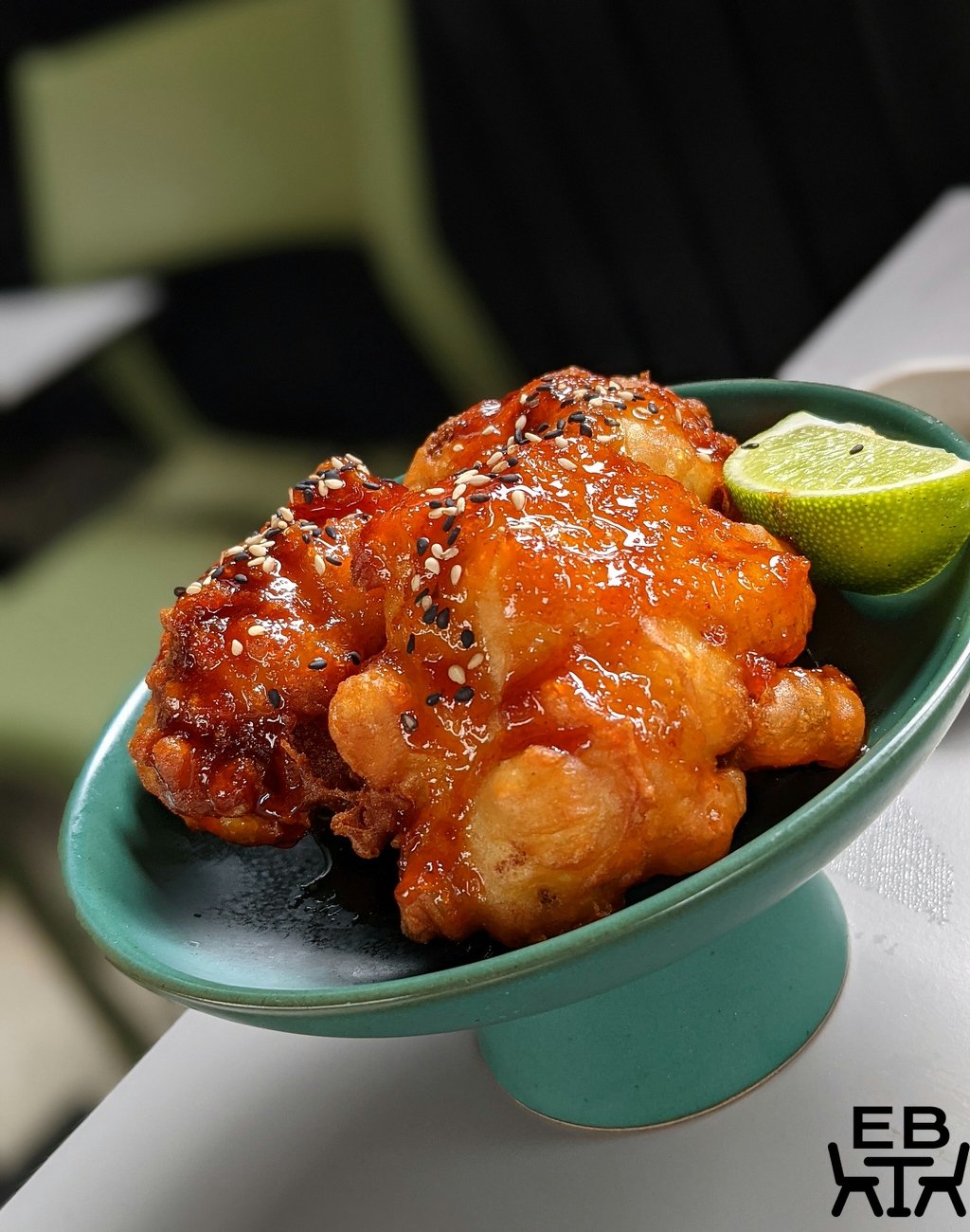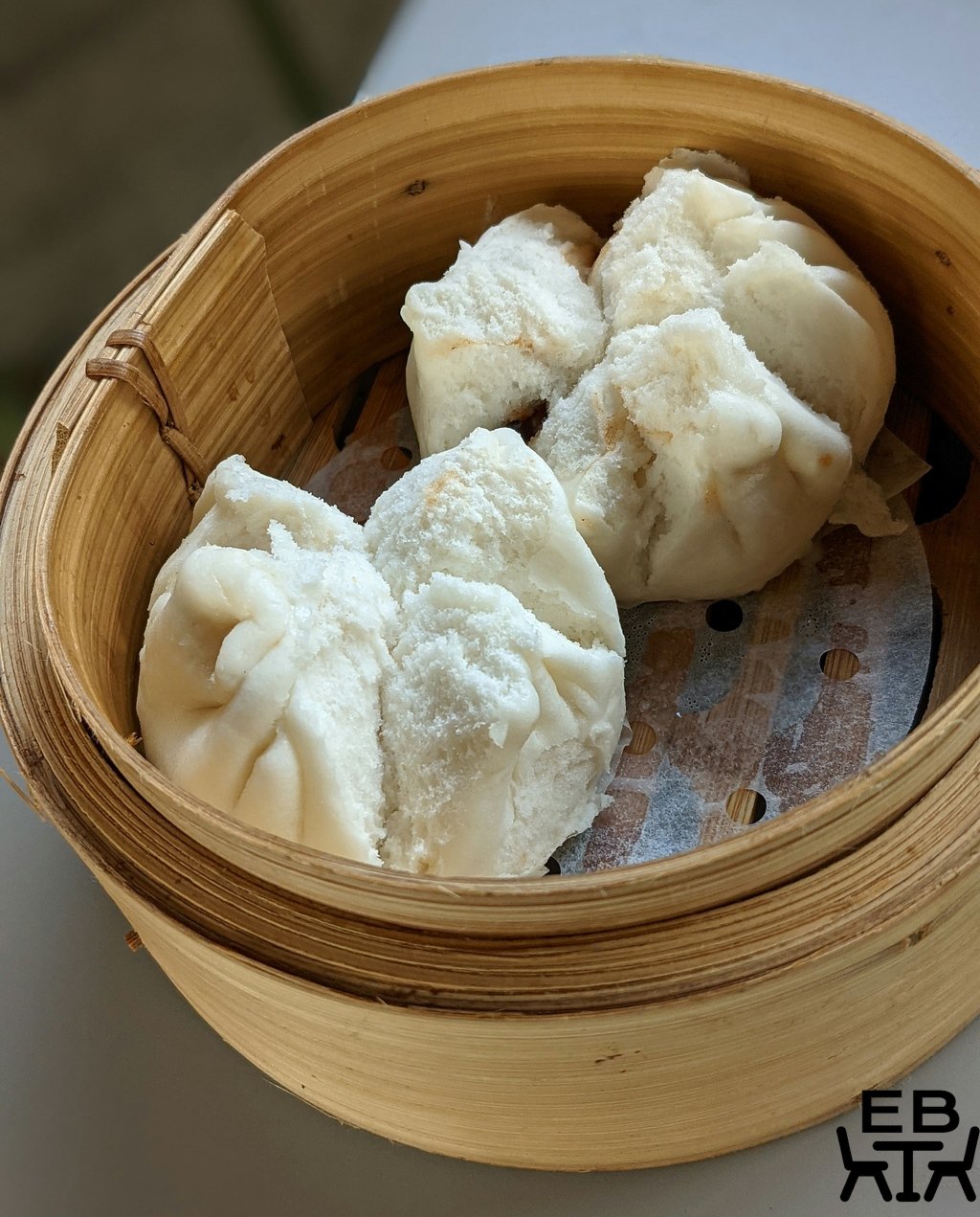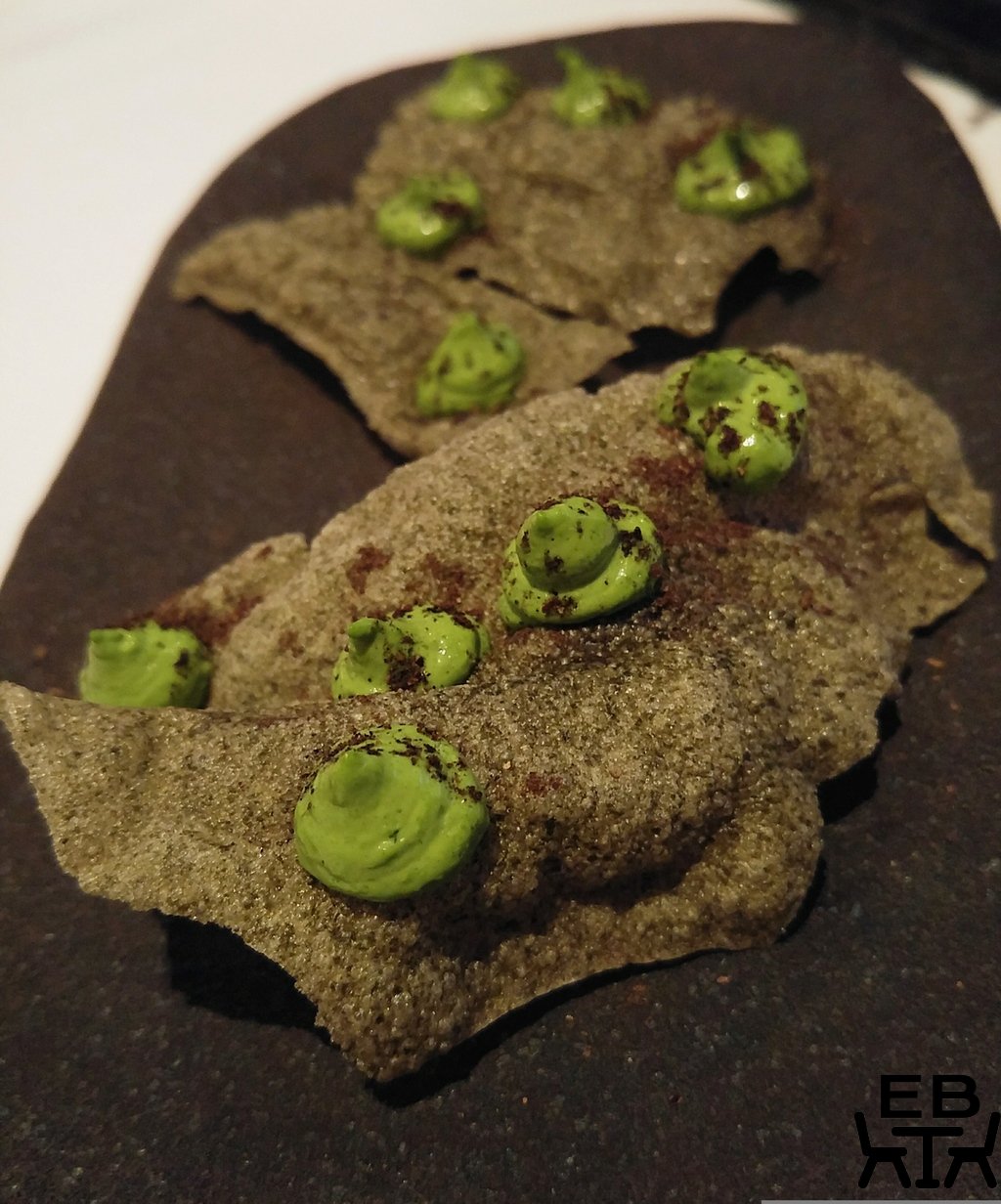Baos Pop Bistro opened in West End at the end of last year. It sits away from the busier section, taking residence on Browning Street, actually in the converted house that Duo West End was previously in. We do appreciate good dumplings, so when we saw that they did yum cha (or dim sum) on Saturdays, decided that it was just the time to visit.
An A-frame on the street corner indicated which way to go, and the eatery itself had visible signage once you were close enough to it (though you wouldn’t see it from the end of the street). One of the signs probably lights up at night, making it stand out more obviously against the dark though.

Their cartoon logo is quite cute, and we realised that if you turn it on its side, it is made of letters that spell “BAO”.
There is a sign just at the entrance that says to wait to be seated. Staff quickly came up from inside the eatery and greeted us. They asked if we had a reservation, and though we had not planned as far ahead as other people, they seated us at a table. We had arrived not too long after their opening time, and as a more typical lunchtime arrived, the tables progressively filled.

Our table was in the covered outdoor seating area. This had been in the process of being constructed when the space was still Duo. Now it was quite serviceable, with a polished concrete floor, a combination of strip lights and pendant lights overhead, and fans. It was quite a warm day though, and there wasn’t quite enough air moving, despite the occasional breeze.

There was a mix of bar height seating, as well as regular height tables. These were configured to fit groups, as well as smaller parties of two. The polymer chairs, in muted tones of an olive green or grey, and the similarly grey tabletops, were a light contrast to the black walls and fence. House music played over the speakers, at a volume that was present, but not so much that it was intrusive.

We did sneak a peek at the interior section, which has fewer tables, but is more comfortably air conditioned, and has a more lush look, with similar dark walls, but jungle green padded seats, and warm downlighting.

A bottle of chilled water was brought to the table, and menus held together by a gold clip. The larger sheet held list of available drinks. The smaller sheet, clipped in front, was a list of food items, headed by “Bao’s Dim Sum, All You Can Eat”. We had thought that there would be a la carte options, but didn’t really have an issue with it being all you can eat instead (who would?).

We decided to try to try everything on the menu, and almost got there. We ordered items as we went rather than just asking for everything at once. If you have been to yum cha before, you will know the risk of getting lots of dishes at the very beginning, then food getting cold as you try to work your way through. We also wanted to avoid wasting food, which can be a risk in all-you-can-eat situations.
We were told that Baos Pop’s all you can eat dim sum comes with either a chilled green tea or a beer. We picked the green tea. These came in a novel presentation, served in glass bottles resembling hip flasks, with “Baos Pop” and the eatery logo printed on them. Small cups, as you would get in a chinese tea set, accompanied them.

The green tea was lightly sweetened, and had a mildly floral flavour. It was cool, rather than cold, but the flavours would likely have been harder to pick out if it was colder.

Because we were there and placed our first orders before most other diners arrived, the first few dishes arrived quite promptly. In order of eating, rather than menu order:
The Pork Xiao Long Bao were served in, in traditional style, a steamer basket. The pork filling was well-seasoned and quite juicy, but we didn’t find soup in the dumplings, which is usually what you anticipate in xiao long bao. The dumpling skins were also quite thick, and somewhat doughy.


The Fried Korean Cauliflower was served on a dish shaped like a pedestal. There were three glistening, candy-red portions, and a wedge of lime. Biting into it, we found that the cauliflower had been battered and fried. The batter was like a fish and chip style batter, rather than a korean fried chicken batter (which might not have adhered to the cauliflower), but it did have a bit of crunch to it. The coating had flavours like the yangnyeom sauce you might find on korean fried chicken, sweet, a little tangy, and definitely packing some spicy kick. It was a moreish dish, and would make good bar food to go with drinks, although it really wasn’t a finger food (unless you are prepared to get messy).


Note, they missed the opportunity to call it Korean Fried Cauliflower – the other KFC.


The Pan Fried Duck Dumplings were also served in a pedestal dish. They were done in gyoza style, with a crispy lattice net. The meat filling was juicy – even more so than the xiao long bao. They were tasty, without being particularly gamey.



The Pork and Prawn Siu Mai were served in a steamer basket, accompanied by a small bowl of what looked like chilli oil. The dumplings again had a nicely seasoned pork filling, and a little prawn in the centre that had a fresh firm texture, rather than being overcooked. The chilli oil, despite its appearance, was very mild. The korean cauliflower actually had more fire.



The BBQ Pork buns, or Char Siu Bao, were pretty classic, with the fluffy white buns holding sweet BBQ pork meat filling. Some places do it with plenty of sauce, to the point that it runs out when you break the buns open. The Baos Pop ones were on the drier side than this, so the meat was well-coated with sweet sauce, but it didn’t make a dribbly mess.



The Wontons in Chilli Sauce were in what seemed to be similar chilli sauce to that served with the siu mai. The wontons had supple, slippery skins, like cloth flowing in water. The chilli sauce was, again, very mild. Perhaps it has been muted for palates that may not be used to spice heat, but the occasional ginger strips on top provided just a hint of the spice really needed for the dish.


The Har Gow were another classic dim sum dish. They were radiantly white in the steamer basket. The filling was perfectly cooked, with the prawns still having a juicy pop.


The Eggplant Chips were served with a bowl of piped mayo to dip. The chips had a good crunchy coating of fine crumb. The eggplant inside that layer was soft, but not squishy or slimy. The chips were also not oily. These would make a good finger food starter or snack.



The Spring Rolls were parcels, rather than the typical rolled shapes. The exterior was flaky and had a crisp shatter. Inside was a shredded vegetable filling that was saucy, but not soggy. We did wait a little bit for them to cool down enough to eat without burning our mouths (they were served hot, clearly fresh from the fryer), but the filling did not compromise the wrapper.



The Duck Fried Rice was a dry, rather than wet fried rice. There were pieces of diced duck meat in it, and plenty of sliced spring onions on top. It was the last dish we had, and it was a good thing we had it right at the end, as it was filling, despite the serve deceptively looking not that large.


Overall, we thought this meal at Baos Pop Bistro was great value. All the food was served piping hot and fresh. While some of the dishes were not quite finessed to perfection, they were reasonable renditions, and as a whole, the dishes available provided a good variety of textures and flavours. Baos Pop certainly did better than some other eateries we have been to that purport to specialise in yum cha..
It is certainly worth visiting. Note that each all-you-can-eat session goes for 1.5 hours, and service can lag a bit when it gets busy (which is probably not unexpected). We would recommend the Pan Fried Duck Dumplings, Fried Korean Cauliflower, and Har Gow in particular. Oh, and you are best booking ahead, so as to avoid missing out.
Scores:
Food: 3/4
Setting: 1/2
Service: 1/2
Total: 5/8
Price point: $25 per person for the all-you-can-eat.
Value: Very good.
Details:
Address: 27 Browning St, South Brisbane
Phone: 07 3844 6191
Website: Baos Pop Bistro







